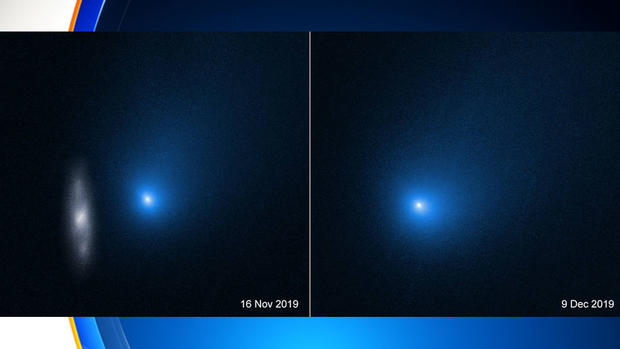Hubble Catches Mysterious Visitor From Beyond, Interstellar Comet, As It Flies Past The Sun
MIAMI (CBSMiami/CNN) -- The Hubble Space Telescope had a front row seat to capture images of a mysterious visitor from the depths of space. It's the first identified comet to arrive here from another star.
It's called the interstellar comet 2I/Borisov, a visitor that originated from outside of our solar system. On Sunday, the comet passed within 190 million miles of Earth on its closest approach before continuing on through our solar system.
As it got closer to Earth, the icy comet shed more gas and dust evaporating through its tail.
This is only the second interstellar object to cross into our solar system after Oumuamua in 2017.
The comet won't remain in our solar system, despite the gravity of our sun, because it's zipping along at 100,000 miles per hour. By June 2020, the comet will be well past Jupiter and on its way back to interstellar space.
New data revealed that the comet is 3,200 feet across -- the length of nine football fields, according to researchers.
"Hubble gives us the best measure of the size of comet Borisov's nucleus, which is the really important part of the comet," said David Jewitt, a professor of planetary science and astronomy at the University of California, Los Angeles, in a press release. "Surprisingly, our Hubble images show that its nucleus is more than 15 times smaller than earlier investigations suggested it might be. The radius is smaller than half a kilometre. This is important because knowing the size helps us to determine the total number, and mass, of such objects in the Solar System, and in the Milky Way. Borisov is the first known interstellar comet, and we would like to know how many others there are."
Two Hubble images were shared, including one from November with a distant spiral galaxy in the frame, when 21/Borisov was 203 million miles from Earth. The second image is from December 9, when the comet was 185 million miles from Earth below the inner edge of the asteroid belt.
Scientists think the comet originated in another star system but was kicked out after a near-miss with a planet.
Since first observing the comet, astronomers determined that the comet is dominated by dust, which is typical for comets. Outside of its hyperbolic orbit, the comet is very similar to those we find in our own solar system. And it has a similar chemical composition to comets in our solar system.
Though comet Borisov is the first of its kind, no doubt there are many other comet vagabonds out there, plying the space between stars. Astronomers will eagerly be on the lookout for the next mysterious visitor from far beyond.
(©2019 CBS Broadcasting Inc. All Rights Reserved. Cable News Network, Inc., a Time Warner Company, contributed to this report.)




